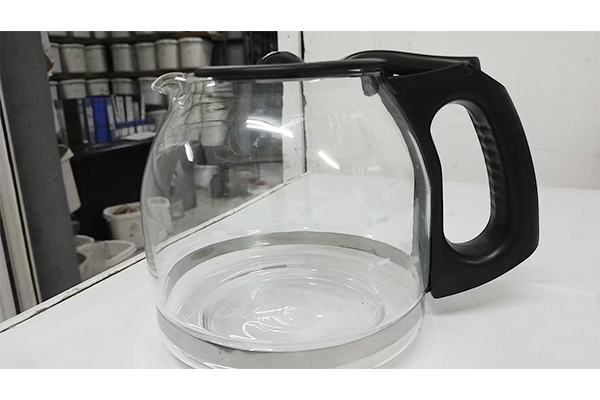How can the coffee pot naked cup withstand extreme temperature swings without breaking?
Release Time : 2025-08-04
The coffee pot naked cup's ability to withstand extreme temperature swings is due to its unique material—borosilicate glass—and its unique physical and chemical properties. It not only demonstrates exceptional stability in daily use, but can also withstand drastic changes from extreme cold to high temperatures, making it a popular choice for drinkware in modern homes and offices.
The core advantage of borosilicate glass lies in its extremely low coefficient of thermal expansion. When objects are heated or cooled, they typically expand or contract in volume, and different materials react to temperature changes to varying degrees. Ordinary glass, due to its high coefficient of thermal expansion, experiences uneven expansion or contraction of its inner and outer layers when suddenly exposed to high or low temperatures, causing stress that can easily lead to cracking or even bursting. However, due to its unique molecular structure, borosilicate glass maintains a relatively stable volume during drastic temperature fluctuations, effectively reducing the accumulation of internal stress. This property ensures that the coffee pot naked cup remains undamaged even when filled with boiling water immediately after being taken out of the refrigerator, demonstrating its exceptional thermal shock resistance.
This material's stability is not only demonstrated by its resistance to high temperatures, but also its suitability for low-temperature environments. It can be safely refrigerated or even frozen for making iced water, cold brew coffee, or chilled drinks. When cooling quickly, users don't have to worry about the container becoming brittle or cracking due to the low temperature. Whether poured with hot water or room-temperature liquids, the pot body quickly adapts to the new temperature environment and maintains its structural integrity. This two-way temperature control adaptability makes the coffee pot naked cup a practical appliance for all seasons, satisfying the need for flexible switching between hot and cold beverages.
In addition to thermal stability, the chemical inertness of borosilicate glass is also a key factor in its resistance to extreme temperature fluctuations. It is not susceptible to chemical reactions with common beverages such as water, tea, coffee, and juice, and it will not corrode or release harmful compounds due to prolonged contact with acids or bases. This stable chemical property not only preserves the original flavor of the beverage but also prevents structural weakening due to aging. Even with frequent use between hot and cold temperatures, the pot body's molecular structure remains strong, and its resistance to temperature fluctuations is not compromised by chemical corrosion.
Furthermore, the manufacturing process of borosilicate glass also supports its excellent performance. During production, the raw materials undergo multiple steps, including high-temperature melting, precision molding, and slow annealing, ensuring a uniform and dense internal structure. The annealing process is particularly critical, as it eliminates internal residual stresses and ensures the finished product is more stable and reliable during subsequent use. This meticulous process control ensures that each coffee pot naked cup has consistent high quality and maintains its performance under various extreme conditions.
Notably, the high strength and impact resistance of borosilicate glass further enhance its ability to withstand temperature fluctuations. Although glass is generally considered fragile, borosilicate glass exhibits higher hardness and toughness than ordinary glass. Its smooth and dense surface is resistant to microcracks and tends to remain intact even after minor bumps or drops. This combination of physical strength and thermal stability makes the coffee pot naked cup more durable and safer in daily use, reducing the trouble of accidental damage.
From a user experience perspective, this resistance to extreme temperature fluctuations also provides great convenience. Whether brewing coffee with boiling water in the morning or placing the teapot in the refrigerator for cold brew in the afternoon, users can do so without worrying about the container's safety. It breaks the temperature limitations of traditional glassware, making tea and coffee drinking more flexible and efficient. Especially in our fast-paced lives, people no longer have to wait for the water temperature to slowly change; they can instantly switch between hot and cold modes, enjoying greater flexibility in their drinking habits.
Furthermore, the transparency of borosilicate glass complements its heat resistance. Users can clearly observe the liquid inside the pot during use, whether it's the bubbles bubbling with hot water or the condensation on cold drinks, providing an intuitive visual experience. This transparency not only adds to the fun of use but also allows users to better control the brewing process, ensuring the taste and quality of their drinks.
In summary, the coffee pot naked cup's ability to withstand extreme temperature fluctuations without breaking is due to the multiple advantages of borosilicate glass, including its low thermal expansion coefficient, chemical stability, high strength, and precision manufacturing process. These properties work together to ensure its structural integrity and safety in alternating hot and cold environments. Each improvement is designed to provide a better user experience and reflects a deep understanding and respect for user needs and social responsibility. In the future, as people's pursuit of healthy living and high-quality utensils continues to increase, borosilicate glass coffee pots will demonstrate their unique value in more scenarios, becoming an elegant vehicle connecting science and life.
The core advantage of borosilicate glass lies in its extremely low coefficient of thermal expansion. When objects are heated or cooled, they typically expand or contract in volume, and different materials react to temperature changes to varying degrees. Ordinary glass, due to its high coefficient of thermal expansion, experiences uneven expansion or contraction of its inner and outer layers when suddenly exposed to high or low temperatures, causing stress that can easily lead to cracking or even bursting. However, due to its unique molecular structure, borosilicate glass maintains a relatively stable volume during drastic temperature fluctuations, effectively reducing the accumulation of internal stress. This property ensures that the coffee pot naked cup remains undamaged even when filled with boiling water immediately after being taken out of the refrigerator, demonstrating its exceptional thermal shock resistance.
This material's stability is not only demonstrated by its resistance to high temperatures, but also its suitability for low-temperature environments. It can be safely refrigerated or even frozen for making iced water, cold brew coffee, or chilled drinks. When cooling quickly, users don't have to worry about the container becoming brittle or cracking due to the low temperature. Whether poured with hot water or room-temperature liquids, the pot body quickly adapts to the new temperature environment and maintains its structural integrity. This two-way temperature control adaptability makes the coffee pot naked cup a practical appliance for all seasons, satisfying the need for flexible switching between hot and cold beverages.
In addition to thermal stability, the chemical inertness of borosilicate glass is also a key factor in its resistance to extreme temperature fluctuations. It is not susceptible to chemical reactions with common beverages such as water, tea, coffee, and juice, and it will not corrode or release harmful compounds due to prolonged contact with acids or bases. This stable chemical property not only preserves the original flavor of the beverage but also prevents structural weakening due to aging. Even with frequent use between hot and cold temperatures, the pot body's molecular structure remains strong, and its resistance to temperature fluctuations is not compromised by chemical corrosion.
Furthermore, the manufacturing process of borosilicate glass also supports its excellent performance. During production, the raw materials undergo multiple steps, including high-temperature melting, precision molding, and slow annealing, ensuring a uniform and dense internal structure. The annealing process is particularly critical, as it eliminates internal residual stresses and ensures the finished product is more stable and reliable during subsequent use. This meticulous process control ensures that each coffee pot naked cup has consistent high quality and maintains its performance under various extreme conditions.
Notably, the high strength and impact resistance of borosilicate glass further enhance its ability to withstand temperature fluctuations. Although glass is generally considered fragile, borosilicate glass exhibits higher hardness and toughness than ordinary glass. Its smooth and dense surface is resistant to microcracks and tends to remain intact even after minor bumps or drops. This combination of physical strength and thermal stability makes the coffee pot naked cup more durable and safer in daily use, reducing the trouble of accidental damage.
From a user experience perspective, this resistance to extreme temperature fluctuations also provides great convenience. Whether brewing coffee with boiling water in the morning or placing the teapot in the refrigerator for cold brew in the afternoon, users can do so without worrying about the container's safety. It breaks the temperature limitations of traditional glassware, making tea and coffee drinking more flexible and efficient. Especially in our fast-paced lives, people no longer have to wait for the water temperature to slowly change; they can instantly switch between hot and cold modes, enjoying greater flexibility in their drinking habits.
Furthermore, the transparency of borosilicate glass complements its heat resistance. Users can clearly observe the liquid inside the pot during use, whether it's the bubbles bubbling with hot water or the condensation on cold drinks, providing an intuitive visual experience. This transparency not only adds to the fun of use but also allows users to better control the brewing process, ensuring the taste and quality of their drinks.
In summary, the coffee pot naked cup's ability to withstand extreme temperature fluctuations without breaking is due to the multiple advantages of borosilicate glass, including its low thermal expansion coefficient, chemical stability, high strength, and precision manufacturing process. These properties work together to ensure its structural integrity and safety in alternating hot and cold environments. Each improvement is designed to provide a better user experience and reflects a deep understanding and respect for user needs and social responsibility. In the future, as people's pursuit of healthy living and high-quality utensils continues to increase, borosilicate glass coffee pots will demonstrate their unique value in more scenarios, becoming an elegant vehicle connecting science and life.







